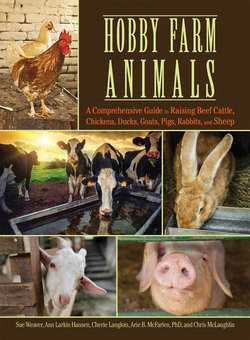Читать книгу Hobby Farm Animals - Chris McLaughlin - Страница 8
На сайте Литреса книга снята с продажи.
Bringing Cattle Home
ОглавлениеOnce you’ve bought your cattle, you have to get them home. If you’re buying from a breeder, he or she may be willing to deliver the cattle for an extra fee. Otherwise, you’ll either have to hire a cattle hauler or do it yourself. There are usually haulers for hire in any area where there’s cattle, and you can track one down by asking neighbors or calling a local auction barn. If your only option, or the option you prefer, is to transport your new livestock yourself, you’ll have to buy, borrow, or rent a trailer (unless you’re buying small calves that you can fit into a pickup or small truck).
When the cattle arrive at your farm, ideally you’ll turn them into a solidly fenced small pen or barnyard, with water available and some nice hay scattered around. Don’t rush them out of the trailer; give them time to look around and step down carefully. Of course, they may decide to all come out in a rush, but let that be their decision. Once they’ve had a few hours to get a drink, find the salt, and get a bellyful of hay, open the pasture gate. By then, they should be calm enough to walk, not run, out. They might start grazing immediately or go on a tour to figure out where the fences are.
If you’re using electric fencing, and the cattle you’ve bought are familiar with it, you can turn them out with no worries. If they don’t know what an electric fence is, you’ll need to train them as discussed in the fence section of Chapter 2. Don’t try to train them as soon as they get off the truck, however. That’s a lot to ask of already-stressed animals and may send them over the fence and back toward their previous home. You can have the wire ready in the pen, but don’t turn it on until they’ve settled down.
You can also turn new cattle directly into the pasture. If you do this, plan on spending some time watching them to make sure they don’t charge and break fences or decide to hop over and head back where they came from. Make sure they find the water, salt, and mineral within twenty-four hours.
Watch your new cattle particularly closely for the first two or three weeks. Are they grazing contentedly, bunched tightly, or spending a lot of time walking instead of chewing? If they’re walking all the time, you’ve got pasture that’s too poor, and you should give them some supplemental hay. If they’re bunched, you probably have a fly problem and should provide a shady area for them to get away from the worst of the flies. You may also need to put up some sort of rub—a rope or padded post impregnated with fly repellent—that will put the repellent on the cattle when they scratch themselves. Are the cattle spending plenty of time lying down and chewing their cud, or are they always standing up and acting nervous? If they aren’t lying down, something is bothering them, and you’ll need to figure out what it is and fix it. Once, we had a bear stroll through the back pasture, and the whole herd went through the fence! We moved the cattle to a paddock close to the house, where the dogs could keep the bears at a distance and the cattle could chew their cuds in peace.
Make sure, too, that your cattle are drinking enough water. In temperate, reasonably dry weather, they’ll come for a drink at least once, and usually twice, a day. If they’re not drinking and it’s not raining, then there’s something wrong with your water setup. I remember one cold winter day when our cattle wouldn’t drink, and I found out why when I touched the water. It was carrying an electric charge from a shorted-out heater!
| ADVICE FROM THE FARM Buyer Beware I like them so they look straight all the way back on their backbone. There’s almost an edge to them. They look upright, they look strong; it’s almost an eager look. I always check the feet—some cattle, it seems like a hereditary thing, have really long hooves. Temperament is a big thing for me, too, with little kids around. I’ve got one cow with a little bit of attitude, but she’s never offered to come after you. I’ve got another one that’s so meek and mild she always gets pushed back. —Randy Janke There’s so much going on now with numbers—expected progeny differences, relative this and that—and it’s so far extended that the average young person needs to just focus on one or two things when choosing breeding stock. The ones I strongly recommend are calving ease and temperament. You need to stick with cattle that won’t explode every time you come around. —Rudy Erickson I’ve never bought from a sale barn. We bought private treaty or from a neighbor’s auction where we knew the herd. —Dave Nesja |
